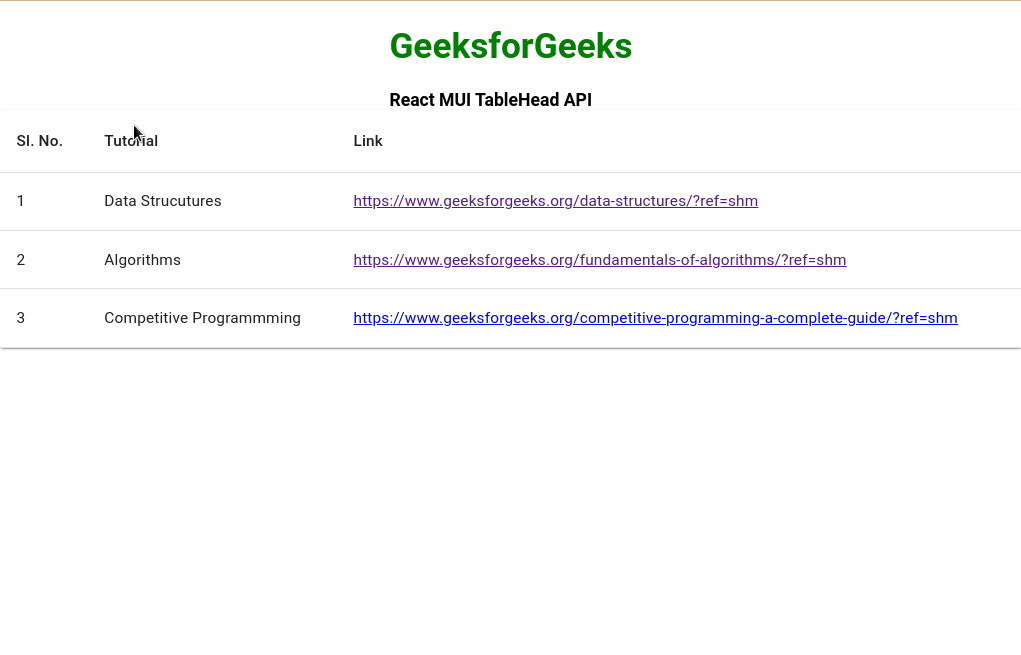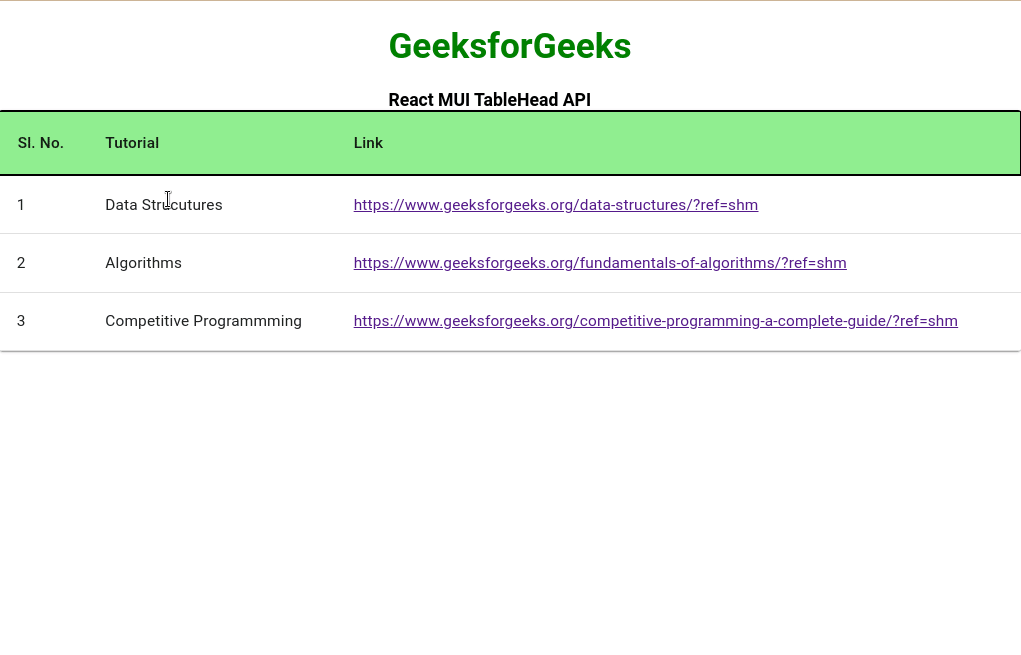MUI o Material-UI es una biblioteca de interfaz de usuario que proporciona componentes robustos y personalizables predefinidos para React para facilitar el desarrollo web. El diseño de MUI se basa en la parte superior de Material Design de Google.
En este artículo, vamos a discutir la API React MUI TableHead. Los encabezados de tabla se utilizan para definir el encabezado del componente de tabla de MUI. Las tablas se utilizan para mostrar una colección de datos de forma organizada. Los encabezados de las tablas se utilizan para definir el nombre de la columna o la categoría. La API proporciona muchas funcionalidades y aprenderemos a implementarlas.
Importar API TableHead
import TableHead from '@mui/material/TableHead';
// or
import { TableHead } from '@mui/material';
Lista de accesorios: aquí está la lista de diferentes accesorios utilizados con este componente. Podemos acceder a ellos y modificarlos según nuestras necesidades.
- children (Node): Es un componente similar a la fila de la tabla.
- clases (Objeto): reemplaza los estilos existentes o agrega nuevos estilos al componente.
- componente (elementType): Es el componente utilizado para el Node raíz. Puede ser una string HTML o un componente.
- sx (Array<func/objeto/bool>/func/objeto): La propiedad del sistema permite definir anulaciones del sistema, así como estilos CSS adicionales
Sintaxis : cree un componente TableHead dentro de la tabla de la siguiente manera:
<Table aria-label="simple table">
<TableHead>
<TableRow>
<TableCell>Sl. No.</TableCell>
<TableCell align="right">Name</TableCell>
<TableCell align="center">Age</TableCell>
</TableRow>
</TableHead>
</Table>
Instalar y crear la aplicación React y agregar las dependencias de MUI.
Paso 1: Cree un proyecto de reacción usando el siguiente comando.
npx create-react-app gfg_tutorial
Paso 2: Entrar en el directorio del proyecto
cd gfg_tutorial
Paso 3: instale las dependencias de MUI de la siguiente manera:
npm install @mui/material @emotion/react @emotion/styled @mui/lab
Paso 4: Ejecute el proyecto de la siguiente manera:
npm start
Ejemplo 1: En el siguiente ejemplo, tenemos una tabla con un encabezado de tabla que tiene tres columnas.
App.js
import "./App.css";
import * as React from "react";
import Table from "@mui/material/Table";
import TableBody from "@mui/material/TableBody";
import TableCell from "@mui/material/TableCell";
import TableContainer from "@mui/material/TableContainer";
import TableHead from "@mui/material/TableHead";
import TableRow from "@mui/material/TableRow";
import Paper from "@mui/material/Paper";
function createData(index = 0, tutorial = "", link = "") {
return { index, tutorial, link };
}
const rows = [
createData(
1,
"Data Structures",
"https://www.geeksforgeeks.org/data-structures/?ref=shm"
),
createData(
2,
"Algorithms",
"https://www.geeksforgeeks.org/fundamentals-of-algorithms/?ref=shm"
),
createData(
3,
"Competitive Programming",
"https://www.geeksforgeeks.org/competitive-programming-a-complete-guide/?ref=shm"
),
];
function App() {
return (
<div className="App">
<div
className="head"
style={{
width: "fit-content",
margin: "auto",
}}
>
<h1
style={{
color: "green",
}}
>
GeeksforGeeks
</h1>
<strong>React MUI TableHead API</strong>
</div>
<TableContainer component={Paper}>
<Table sx={{ minWidth: 650 }} aria-label="simple table">
<TableHead>
<TableRow>
<TableCell>Sl. No.</TableCell>
<TableCell>Tutorial</TableCell>
<TableCell>Link</TableCell>
</TableRow>
</TableHead>
<TableBody>
{rows.map((row) => (
<TableRow key={row.name}>
<TableCell component="th" scope="row">
{row.index}
</TableCell>
<TableCell>{row.tutorial}</TableCell>
<TableCell>
<a href={row.link} target="_blank">
{row.link}
</a>
</TableCell>
</TableRow>
))}
</TableBody>
</Table>
</TableContainer>
</div>
);
}
export default App;
Producción:

Ejemplo 2: en el siguiente ejemplo, hemos agregado el campo sx prop para personalizar los bordes y el fondo del encabezado de la tabla.
App.js
import "./App.css";
import * as React from "react";
import Table from "@mui/material/Table";
import TableBody from "@mui/material/TableBody";
import TableCell from "@mui/material/TableCell";
import TableContainer from "@mui/material/TableContainer";
import TableHead from "@mui/material/TableHead";
import TableRow from "@mui/material/TableRow";
import Paper from "@mui/material/Paper";
function createData(index = 0, tutorial = "", link = "") {
return { index, tutorial, link };
}
const rows = [
createData(
1,
"Data Structures",
"https://www.geeksforgeeks.org/data-structures/?ref=shm"
),
createData(
2,
"Algorithms",
"https://www.geeksforgeeks.org/fundamentals-of-algorithms/?ref=shm"
),
createData(
3,
"Competitive Programming",
"https://www.geeksforgeeks.org/competitive-programming-a-complete-guide/?ref=shm"
),
];
function App() {
return (
<div className="App">
<div
className="head"
style={{
width: "fit-content",
margin: "auto",
}}
>
<h1
style={{
color: "green",
}}
>
GeeksforGeeks
</h1>
<strong>React MUI TableHead API</strong>
</div>
<TableContainer component={Paper}>
<Table sx={{ minWidth: 650 }} aria-label="simple table">
<TableHead
sx={{
backgroundColor: "lightgreen",
borderColor: "black",
borderWidth: "2px",
borderStyle: "solid",
padding: "4px",
}}
>
<TableRow>
<TableCell>Sl. No.</TableCell>
<TableCell>Tutorial</TableCell>
<TableCell>Link</TableCell>
</TableRow>
</TableHead>
<TableBody>
{rows.map((row) => (
<TableRow key={row.name}>
<TableCell component="th" scope="row">
{row.index}
</TableCell>
<TableCell>{row.tutorial}</TableCell>
<TableCell>
<a href={row.link} target="_blank">
{row.link}
</a>
</TableCell>
</TableRow>
))}
</TableBody>
</Table>
</TableContainer>
</div>
);
}
export default App;
Producción:

Referencia: https://mui.com/material-ui/api/table-head/
Publicación traducida automáticamente
Artículo escrito por RajeevSarkar y traducido por Barcelona Geeks. The original can be accessed here. Licence: CCBY-SA